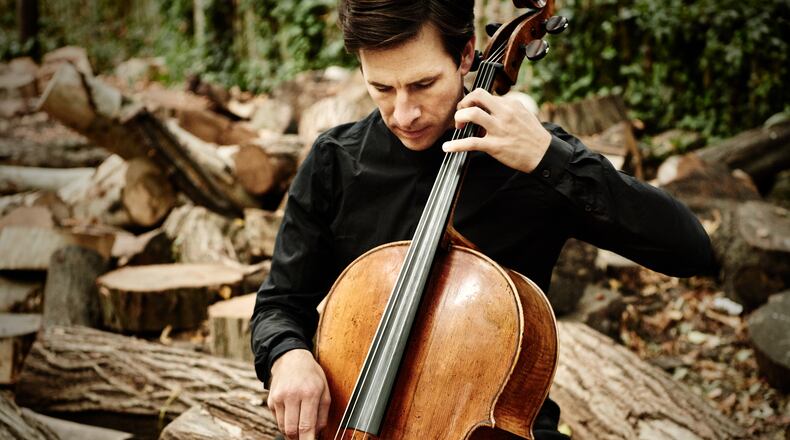Marquee events at prestigious venues typically soak up our attention, with the Atlanta Symphony Orchestra and Spivey Hall understandably taking the lion’s share of the classical scene. So it’s a thrill to discover a new series that exceeds all expectation.
Music at St. Luke’s, at the historic Episcopal church that sits on the boundary between Downtown and Midtown on Peachtree Street, debuted last year, all virtual. Its second season, with a masked audience, opened Oct. 29 with an outstanding recital from cellist Guy Johnston and pianist Chiao-Wen Cheng, both on the faculty of the Eastman School of Music in Rochester, New York.
Johnston plays a gorgeous 1714 David Tecchler cello with a golden honey varnish. He could be mistaken for actor Benedict Cumberbatch. At 40, he is a rising star. (Historically, unlike violin prodigies, cello soloists are often late bloomers, from Emanuel Feuermann to Lynn Harrell, playing in an orchestra or chamber ensemble before developing a major solo career.) Johnston seems to have it all. His communication is direct, his playing lyrical and unmannered, his tone robust and soulful. He plays with the kind of understated (but technically perfect) virtuosity and charisma that makes it all look effortless.
Cheng played St. Luke’s 6-foot Steinway, a nice instrument that, owing to its intermediate size, only lacked a strong bass presence. As a partner she was nimble and always elegant, comfortable in the accompanying role.
Their program covered a lot of territory, including a compelling new work written for Johnston, the Sonata for Cello and Piano by English composer Joseph Phibbs. The 18-minute sonata, written earlier this year, received its first performance in September at a music festival in England, a co-commission with London’s esteemed Wigmore Hall. At St. Luke’s, we heard its U.S. premiere.
The Phibbs sonata doesn’t sound like film music, but nevertheless suggested a strong narrative component. It begins with “Prelude,” where the cello plays a dark, questioning theme, with the piano burbling below. We hear and feel the effects of light and shadow, foreground and background. The cello’s mood grows assertive and somehow self-aware, as if this were about a hero and his quest. Modal harmonies, in brief flashes, places our protagonist in an exotic locale or medieval soundscape.
The second movement is marked “Threnody,” a hymn of mourning for the dead, but even if you hadn’t read the program notes you’d hear that the cellist seems to cry out with the pain of loss. A dazzling, moto perpetuo third movement is all vigor and non-stop action, as if a battle scene.
Then comes the memorable heart of the sonata, “Pavyn,” based on a 16th-century pavane for lute from Queen Elizabeth I’s court. Its long-short-short pulse and an ascending, four-note little theme, plucked by the cellist (as if a lute), is deeply satisfying to hear. Those four notes, made prominent in the “Pavyn,” had been hinted at earlier in the sonata — as if a loose, dreamy image were suddenly made real. The piano is a ghostly character, hovering in the background, slipping in and out of silence. The “Nocturne” movement prowls around on high alert, dangerous and threatening. The final “Vocalise” movement is perhaps least compelling, a squishy resolution to what’s been an expertly embroidered and emotional journey. One suspects Johnston will soon record this strong new work.
In 1941, the visionary French composer Olivier Messiaen was in the Nazi’s Stalag VIIIA prison-of-war camp in what’s now Poland. Using the partially broken instruments in the camp — a violin, cello, clarinet and piano — he composed “Quartet for the End of Time,” a searing, hopeful meditation on the Catholic faith and the apocalypse, drawn from Messiaen’s idiosyncratic reading of the Bible’s Book of Revelation. He performed it with fellow prisoners for a captive audience of 5,000.
The fifth movement, for just cello and piano, is titled “Praise for the Eternity of Jesus” and marked “infinitely slow, ecstatic.” Yet Johnston and Cheng played with more forward propulsion than I’ve ever heard it performed. At this tempo, it flips the static, infinitely sad mood into a limpid, loving ode, an extended moment of great beauty. On this program, shorn of the “Quartet for the End of Time’s” full narrative arc and somber mood, perhaps it made some sense to interpret the movement differently, to better integrate it into the recital. It made me rethink key elements of how the quartet are interpreted, and why. In effect, they made an old familiar work entirely new. Brilliant.
The duo were at full power, with utter joy, for Edvard Grieg’s Sonata in A minor, from 1883, a brawny and lyrical display of technical and emotional power. This was high-level playing, ideally balanced, breathing as one.
The evening wasn’t all perfection. They started with J.S. Bach’s Sonata in G major (BWV 1027), originally for viola da gamba, a low-voiced stringed instrument with frets that’s held between the legs (gamba), and backed by accompanying harpsichord. The modern cello and piano bring their own palette of colors and sound to the music.
Its placement reminded me of a dumb saying fed to students when planning a recital in music schools, maybe even at Eastman: If you can open with Bach you can open with anything! It suggests that, since Bach is complex and direct and there’s no place to hide, why not open your concert with the deceptively hardest piece — everything will seem easy after that.
Alas, Johnston and Cheng, playing in an unfamiliar room of hard surfaces and ringing acoustics, fell into that trap. Their Bach was soupy and a little frantic, the piano too loud, as their ears searched for stability and their fingers couldn’t rely on muscle memory. But by the end they’d found their composure as a duo. Their Bach was the sacrifice that benefited the rest of the program.
Still, it was a highly rewarding evening of music. Why St. Luke’s? Johnston and Cheng received the invitation from Matthew Michael Brown, the church’s director of music, who was a student at Eastman along with Johnston. Connections matter, and Atlanta continues to grow, if slowly, on an upward spiral.
The Music at St. Luke’s series continues Nov. 14 with Francis Poulenc’s “Gloria,” sung by the Georgia Tech Chamber Choir. As always, the concerts are free.
4 p.m. Nov. 28: Advent Lessons and Carols
Noon Dec. 3: Georgia State University Guitar Studio
7 p.m. Dec. 5: 45th annual Messiah Sing Along with members of the Atlanta Symphony
Noon Dec. 10: Pianist Portia Shuler Hawkins
Noon Dec. 17: Atlanta Jazz Trio
7:30 p.m. Feb. 25: Organist Stephen Tharp
4:15 p.m. March 6: Organ Recital by Ahreum Han
5:00 p.m. March 6: Choral Evensong
7:30 p.m. April 1: Pianist Matthew Manwarren
4:15 p.m. May 15: Recital by Cain-Oscar Bergeron, baroque flutist
5:00 p.m. May 15: Choral Evensong
7:30 p.m. May 20: 2nd Annual Concert for a Cause with baritone Sidney Outlaw and pianist Warren Jones
Credit: ArtsATL
Credit: ArtsATL
Working closely with the American Press Institute, The Atlanta Journal-Constitution is embarking on an experiment to identify, nurture and expand a network of news partnerships across metro Atlanta and the state.
Our newest partner, ArtsATL (www.artsatl.org), is a nonprofit organization that plays a critical role in educating and informing audiences about metro Atlanta’s arts and culture. Founded in 2009, ArtsATL’s goal is to help build a sustainable arts community contributing to the economic and cultural health of the city.
Over the next several weeks, we’ll be introducing more partners, and we’d love to hear your feedback.
You can reach Managing Editor Mark A. Waligore via email at mark.waligore@ajc.com.
About the Author
The Latest
Featured


